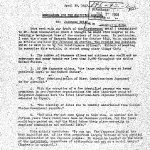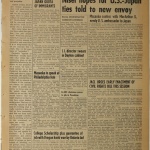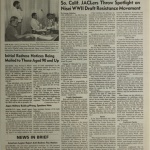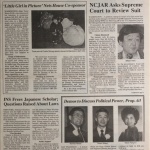Coram nobis cases
General term for legal cases filed during the 1980s to overturn the criminal convictions of three Nisei prosecuted for violating World War II curfew and exclusion orders. The coram nobis cases resulted from researchers' discovery in the early 1980s of wartime documents showing that government attorneys withheld, altered, and destroyed evidence favorable to Japanese Americans and made false claims that Nikkei were security threats.
These revelations led attorneys for Gordon Hirabayashi , Fred Korematsu , and Minoru Yasui to file petitions for a writ of error coram nobis , a rarely-used legal procedure to correct a fundamental error in a trial after the defendant has been convicted and served a sentence. "Coram nobis" means "before us." A petition for a writ of error coram nobis asks a court to vacate a criminal conviction based on an error that occurred "before" the court and resulted in a manifest injustice.
These cases—whose five-year journeys paralleled and sometimes meshed with the Redress Movement —challenged the validity of landmark Supreme Court decisions, held great symbolic value for Japanese Americans, received widespread publicity, and helped to educate the general public about the unsubstantiated claims underlying the military's justification for forced removal and mass incarceration of Japanese Americans.
Basis for the Coram Nobis Cases
In 1981, legal scholar Peter Irons and Aiko Herzig-Yoshinaga , chief researcher for the Commission on Wartime Relocation and Internment of Civilians (CWRIC) , discovered documents in the National Archives proving that government officials during World War II had suppressed, altered, and destroyed material evidence in the Hirabayashi , Yasui and Korematsu cases contradicting the government's claims, particularly those of General John L. DeWitt , of a military necessity for the forced removal of Japanese Americans from the West Coast.
First, the government suppressed intelligence reports from the Office of Naval Intelligence , the FBI, and the Federal Communications Commission that contradicted claims of military necessity for the mass removal. In January 1942, Lt. Kenneth Ringle of the Office of Naval Intelligence submitted a report that concluded "the entire 'Japanese problem' has been magnified out of its true proportion, largely because of the physical characteristics of the people . . . and . . . that it should be handled on the basis of the individual, regardless of citizenship, and not on a racial basis." [1] In a 1943 memo Irons discovered, Edward Ennis , director of the Justice Department's Alien Enemy Control Unit, wrote to Solicitor General Charles Fahy expressing concern with the government's arguments in court in light of the Ringle memorandum: "the Government is forced to argue that individual selective evacuation would have been impractical and insufficient when we have positive knowledge that the only Intelligence agency responsible for advising General DeWitt gave him advice directly to the contrary." Ennis encouraged Fahy to reveal the Ringle report to the high court, arguing "that any other course of action might approximate the suppression of evidence." [2] Fahy refused.
Ennis was also troubled by DeWitt's false assertion that Japanese Americans had engaged in shore-to-ship radio signaling, even though DeWitt knew of FBI and FCC reports contradicting such claims. On February 7, 1944, for example, FBI Director J. Edgar Hoover wrote Attorney General Francis Biddle that accusations of illegal signaling were baseless: "[T[here is no information in the possession of this Bureau . . . which would indicate that the attacks made on ships or shores in the area immediately after Pearl Harbor have been associated with any espionage activity ashore or that there has been any illicit shore-to-ship signaling, either by radio or lights." [3]
Justice Department attorney John Burling drafted a footnote in the government's Korematsu brief to advise the Supreme Court that the government had information conflicting DeWitt's claims, particularly with reference to illegal signaling by Japanese Americans. Fahy revised the footnote so that the Court would never know of the contrary intelligence reports. Burling wrote to Assistant Attorney General Herbert Wechsler, objecting to the revised footnote on the ground that there was no doubt that the claims of illegal signaling were "intentional falsehoods" flatly contradicted by the FBI and FCC. [4]
Ennis also wrote to Wechsler, urging that the Department's obligations to the Court required that the footnote remain as Burling had drafted it. He stated that the general tenor of DeWitt's Final Report "is not only to the effect that there was a reason to be apprehensive [about Japanese Americans], but also to the effect that overt acts of treason were being committed. Since this is not so, it is highly unfair to this racial minority that these lies, put out in an official publication, go uncorrected." [5]
Second, Herzig-Yoshinaga discovered that General DeWitt's Final Report, Japanese Evacuation from the West Coast, 1942 , had been altered to support the government's arguments before the Supreme Court. In the Hirabayashi and Korematsu cases, the government argued that curfew and forced removal orders were necessary because there was insufficient time to separate loyal Japanese Americans from those who might be disloyal. In his original report, however, DeWitt said that insufficient time to determine loyalty was not a reason for the mass removal of Japanese Americans. Instead, he believed that determining the loyalty of Japanese Americans was impossible; one could never separate the "sheep from the goats." When it became clear that DeWitt's report contradicted the government's arguments, the report was revised to support the government's claim of insufficient time to screen Japanese Americans. The Supreme Court received the new, altered copy in the Korematsu case.
Irons located Hirabayashi and Yasui and described the evidence he and Herzig-Yoshinaga had unearthed. He explained that these documents were grounds to challenge their criminal convictions. Both Hirabayashi and Yasui enthusiastically decided to reopen their cases. Upon learning about the damning documents, Hirabayashi told Irons, "I've been waiting over forty years for this call." [6]
Korematsu was at first hesitant about talking with Irons. Irons visited Korematsu's San Leandro, California, home in 1982 and showed him the evidence of the government's misconduct. Korematsu thoughtfully examined the documents. After some time, he looked at Irons and said, "They did me a great wrong." [7] Korematsu asked Irons if he was a lawyer and would represent him. Irons, who in addition to being a professor was also an attorney, agreed.
Although Irons was an attorney, he did not practice law and knew that he could not handle the cases alone. He also felt that Japanese Americans should take the lead in the litigation, a remarkable position given the significance of the cases and potential notoriety they would attract. He asked Yasui for the names of West Coast Nikkei lawyers. Yasui provided a list which included Dale Minami , a young Sansei attorney based in Oakland.
Irons contacted Minami, not only because he was on Yasui's list, but also because he had heard of Bay Area Attorneys for Redress, a group Minami worked with that had submitted testimony to the CWRIC on the constitutional violations resulting from the mass incarceration. Minami eagerly responded to Irons' request for help. Minami recruited other attorneys in the San Francisco Bay Area, and eventually led the team representing Fred Korematsu.
Gordon Hirabayashi asked Seattle civil rights attorney Kathryn Bannai to represent him and form a legal team. Hirabayashi had worked with Bannai on Seattle Chapter JACL-sponsored programs in 1981 comparing the experiences of Japanese Americans and Japanese Canadians, and in the Redress Movement.
Minami knew only one Japanese American attorney in Portland, Oregon, the site of Yasui's conviction: Peggy Nagae, who had worked for Legal Aid Services of Oregon, had a civil rights background, and was transitioning to a position as the Assistant Dean of the University of Oregon School of Law. When Minami contacted Nagae to ask her to represent Yasui, she not only agreed but explained she knew that Yasui had been her father's attorney in a World War II curfew violation case. She deferred the start of her new job to work on the Yasui coram nobis case and became Yasui's lead counsel.
Both Nagae and Bannai assembled legal teams in their respective cities. Most of the attorneys who joined the Korematsu, Hirabayashi, and Yasui coram nobis efforts were Sansei whose families had been incarcerated; many had been involved in the movement for Japanese American redress. But a number of the lawyers came from a diverse spectrum of racial and ethnic backgrounds: white, other Asian Americans, Latinx, and Black. The attorneys also represented a wide range of professional work, including private practice and legal services.
During a May 8-9, 1982, meeting at Minami's Oakland home, Irons met more than a dozen West Coast attorneys and law students to present and discuss the evidence he and Herzig-Yoshinaga had uncovered. He also shared his idea of reopening the Korematsu , Hirabayashi , and Yasui cases through the unusual coram nobis process. Coincidentally and fortuitously, Irons was familiar with the rare writ through his own successful litigation employing the writ. The documents Irons presented stunned the attorneys. They recognized this evidence provided a once-in-a-lifetime opportunity to re-open the cases; correct history; impair the dangerous precedents of the Korematsu , Hirabayashi and Yasui Supreme Court decisions; and right a historic wrong that had impacted many of their families.
Setting Strategy
The attorneys worked pro bono (without expectation of pay) to represent Yasui, Korematsu, and Hirabayashi, most volunteering on the cases after their "day jobs."
The lawyers debated the merits and drawbacks of filing a consolidated case for all three Nisei directly with the Supreme Court, as opposed to individual cases filed in the district (or trial) courts in which each man had initially been tried. For several reasons, the attorneys decided to file separate cases in the district courts—in San Francisco for Korematsu, Portland for Yasui, and Seattle for Hirabayashi. The lawyers believed their chance for success in the conservative Supreme Court of the early 1980s was weaker than in the district courts. In addition, filing three separate cases gave the attorneys multiple opportunities to make their arguments.
The coram nobis attorneys framed their efforts not only as litigation to overturn the three men's convictions, but also as political work to educate the public about the unjust incarceration. They recognized that the cases would draw attention to the Redress Movement. By filing in the district courts, the attorneys created three opportunities for media coverage and publicity.
The San Francisco, Seattle, and Portland teams prepared identical coram nobis petitions requesting that the three Nisei's criminal convictions be overturned and that the district courts find that government officials engaged in misconduct. Before filing the first petition, though, the legal teams kept their work largely confidential. Their petitions included allegations against high government officials, many of whom were still living and in positions of power. The attorneys feared that government documents potentially helpful for their cases might go missing.
Arthur Goldberg , a former Supreme Court justice and a member of the CWRIC, learned of the coram nobis efforts before the attorneys filed the first petition. In a letter published in the Japanese American press, he stated that the coram nobis cases were unnecessary and potentially damaging. He wasn't aware, however, of the evidence the attorneys had gathered to back their arguments.
The legal teams filed Korematsu's petition first for a number of reasons: They believed that the San Francisco district court included the most judges who would understand the issues and history behind the petition, and who would be courageous enough to accept unprecedented arguments to overturn a forty-year-old conviction in a landmark case. In addition, because the Supreme Court issued its Korematsu ruling a year after the Hirabayashi and Yasui decisions, there was more evidence of government wrongdoing. Finally, the San Francisco team had a larger core of lawyers able to work on research, document review, outreach, and fundraising.
On January 19, 1983, Korematsu, Yasui, and Hirabayashi, joined by members of their legal teams, formally announced their coram nobis petitions at a press conference in San Francisco that more than one hundred reporters attended. The announcement received widespread press coverage in network news, other mainstream media, and the Japanese American press.
Korematsu Case
Korematsu's legal team included Irons, Minami, Lorraine Bannai , Don Tamaki, Dennis Hayashi, Robert Rusky, Karen Kai, Ed Chen, Eric Yamamoto, Mike Wong, Donna Komure and Leigh-Ann Miyasato.
When Korematsu's legal team filed his petition on January 19, 1983, the request for coram nobis relief was so rare that a court clerk asked a supervisor how to process it. Judge Marilyn Hall Patel was randomly assigned to the case. Justice Department lawyer Victor Stone represented the government, as he did in the subsequent Yasui and Hirabayashi litigation.
The government sought to delay decision in the case, citing both the ongoing work of the CWRIC and the slow-moving nature of government decision-making. After fruitless discussions about a presidential pardon (in rejecting the offer of a pardon, Korematsu famously replied, "We should be the ones pardoning the government"), Stone filed the government's response on October 4, 1983: it was a two-page document asking the court to vacate Korematsu's conviction without addressing the claim of government misconduct.
At a hearing on November 10, 1983, attended by more than three hundred spectators, most of them Nisei and Sansei, Minami requested a judicial declaration acknowledging the serious government misconduct contributing to Korematsu's conviction. Minami believed a favorable ruling would bolster the Redress Movement, vindicate Nikkei who had been unjustly incarcerated, and serve as a deterrent to future government wrongdoing.
Judge Patel allowed Korematsu to make a statement. He described the stigma he and other Japanese Americans still felt regarding their unjust imprisonment. He concluded by explaining, "As long as my record stands in federal court, any American citizen can be held in prison or concentration camp without a trial or hearing. That is if they look like the enemy of our country. Therefore, I would like to see the government admit that they were wrong and do something about it so that this will never happen again to any American citizen of any race, creed or color." [8]
Judge Patel rejected Stone's argument, ruling that the government could not retroactively decide that it was incorrect to have prosecuted Korematsu after he had exhausted all of his appeals and served his sentence. She added that the government had failed to respond to the allegations of misconduct. She considered that failure as "tantamount to a confession of error." [9]
Judge Patel unexpectedly issued her decision from the bench. She vacated Korematsu's conviction, explaining that Executive Order 9066 and the forced removal orders were based on "unsubstantiated facts, distortions, and representations of at least one military commander, whose views were seriously infected by racism." [10] She stated that the Supreme Court's Korematsu decision should stand as a "caution that in times of distress the shield of military necessity or national security must not be used to protect governmental actions from close scrutiny and accountability, and that in times of international hostility and antagonisms our institutions must take the leadership, whether those institutions be the legislative branch, the executive branch or the judicial branch, to protect all citizens from the petty fears and prejudices that are so easily stirred up during those times." [11]
The government appealed but in June 1984 withdrew its appeal.
Judge Patel's decision was the first judicial declaration that the original Japanese American wartime cases rested on a foundation of fraud and therefore were fundamentally flawed. This holding was important for Congressional representatives who supported redress legislation to rebut claims of redress opponents that the Supreme Court decisions were obstacles to redress.
Yasui Case
Attorneys Peggy Nagae (lead counsel), Russell Aoki, Jeffrey Beaver, Frank Chuman , Fern Eng, Bert Fukumoto, Stephen Griffith, William Scott Meisner, Mary Mori, Clayton Patrick, and Don Willner represented Yasui, assisted by members of the other coram nobis teams. They filed Yasui's coram nobis petition on January 31, 1983, the same day Hirabayashi's attorneys filed his petition.
Portland Judge Robert C. Belloni held a hearing on January 16, 1984. Nagae and Willner explained the harm the wartime exclusion and incarceration inflicted on Japanese Americans. Yasui told Judge Belloni that the Supreme Court decision in his case damaged his faith in the Constitution. He asked the court to restore his faith that Constitutional rights apply to people of all races and creeds.
As he did in Korematsu's case, the government's attorney, Victor Stone, asked the court to vacate Yasui's conviction but dismiss the petition without addressing the claim of governmental wrongdoing.
On January 26, 1984, Judge Belloni granted the government's motion to vacate Yasui's conviction, but refused to address the allegations of government misconduct. Yasui considered the ruling "a hollow personal victory," and instructed his attorneys to appeal to the Ninth Circuit Court of Appeals.
After Yasui died on November 12, 1986, the government moved to dismiss the case, and the appellate court agreed. Yasui's family appealed to the United States Supreme Court in June 1987, arguing that the case was not moot because of Yasui's death. The larger principle of equality under the law was at stake. But on October 5, 1987, the high court declined to hear the appeal. Honoring Yasui's wish to exhaust all legal options, Nagae filed a second petition to the Supreme Court to reconsider its decision. On November 30, 1987, the high court refused, thereby ending the case.
Hirabayashi Case
Gordon Hirabayashi's petition, filed on January 31, 1983, was the last of the three cases to receive a hearing. Given the differing outcomes in the Korematsu and Yasui coram nobis litigation, Hirabayashi's case took on added significance.
The Hirabayashi coram nobis team included Kathryn Bannai (who was Hirabayashi's first lead counsel but stepped down in February 1985 due to her new parenting responsibilities), Rod Kawakami (who became lead counsel in 1985), Michael Leong, Benson Wong, Camden Hall (trial co-lead counsel), Gary Iwamoto, Daniel Ichinaga, Jeffrey Beaver, Karen Narasaki, Roger Shimizu, Diane Narasaki, Nettie Alvarez, Richard Ralston, Craig Kobayashi, Jerald Nagae, Sharon Sakamoto, Nina Mar, and Arthur Barnett , an attorney who had not only accompanied Hirabayashi when he surrendered to the FBI in 1942, but served on Hirabayashi's original defense team.
Before a packed courtroom in Seattle on May 18, 1984, Judge Donald S. Voorhees conducted a hearing during which he considered arguments presented by Victor Stone, representing the government, and by Kathryn Bannai and Camden Hall. [12] In addition, he permitted Hirabayashi and Arthur Barnett to make statements. Hirabayashi pointed to the publicly-expressed sentiment that favored interning persons of Iranian ancestry during the 1979-80 hostage crisis in Iran. He continued: "My case stands for the precedent that it can happen again. This is not only my case. This is not only a Japanese American case. This is an American case. Since the answer to the question 'Can it happen again?' is yes, it is vitally important during relative periods of calm to ensure that 'bizarre solutions' have less opportunity to occur again." [13] Judge Voorhees denied the government's motion to dismiss the petition, and granted Bannai's request for an evidentiary hearing, "in effect, a trial on the coram nobis" petition. [14]
In the order that followed, Judge Voorhees restated his conclusion that a showing had been made "that evidence essential to [Hirabayashi's] defense at his trial or upon his appeal may have been knowingly suppressed by the government" and, therefore, that Hirabayashi "may have been deprived of due process in those proceedings." [15] Judge Voorhees scheduled the evidentiary hearing to begin on June 17, 1985.
Significantly, Hirabayashi's case was the only coram nobis case to receive a trial on the merits of the petition. [16] During the two-week hearing, former Justice Department lawyer Edward Ennis was the coram nobis team's star witness. He recounted government officials suppressing evidence in 1943–44. Herzig-Yoshinaga and Irons also testified on their research.
Stone argued that there was a military necessity to remove and incarcerate Japanese Americans during World War II. David Lowman, the most vocal proponent of the "Magic Cables ," was his key witness. Jack Herzig, Aiko Herzig-Yoshinaga's husband and a retired military counter-intelligence officer, testified and refuted Lowman's claims. Stone also called on military and FBI officials.
On February 10, 1986, Judge Voorhees issued his written opinion. He vacated Hirabayashi's conviction for violating the forced removal order. But he refused to overturn Hirabayashi's conviction for violating the curfew order, reasoning that, because a curfew was a minor barrier to freedom, the wartime Supreme Court would have upheld the curfew orders regardless of government attorneys' wrongdoing.
Both sides appealed. A three-judge panel of the Ninth Circuit Court of Appeals heard arguments on March 2, 1987. On September 24, 1987, the panel issued its unanimous decision not only upholding Judge Voorhees's decision vacating Hirabayashi's forced removal conviction but also overturning Hirabayashi's curfew conviction.
Judge Mary M. Schroeder, writing for the panel, agreed with the charges of governmental misconduct, noting that the Supreme Court's decisions "probably would have been materially affected." In vacating Hirabayashi's curfew conviction, the appellate judges rejected Stone's claim that the Supreme Court would have reached the same decision regardless of whether government officials had suppressed evidence and had accurately conveyed General DeWitt's motivations. Schroeder wrote that "the information now in the public record constitutes objective and irrefutable proof of the racial bias that was the cornerstone of the internment orders." [17]
The government asked the full panel of Ninth Circuit judges to re-hear the case. After the appellate court refused, the government decided not to appeal to the Supreme Court. Hirabayashi's conviction for violating the curfew order was vacated on January 12, 1988.
Continuing Impact of the Coram Nobis Cases
In 1998, President Bill Clinton awarded Fred Korematsu the Medal of Freedom, the nation's highest civilian honor. President Barack Obama bestowed the same award, posthumously, to Gordon Hirabayashi and Min Yasui in 2012 and 2015, respectively.
Several documentaries focus on the coram nobis cases, notable among them are Steven Okazaki's Oscar-nominated Unfinished Business (1986), Fighting for Justice: The Coram Nobis Cases (1999), Eric Paul Fournier's Emmy-award winning Of Civil Wrongs and Rights: The Fred Korematsu Story (2000), and Never Give Up: Minoru Yasui and the Fight for Justice , a film produced and co-directed by Yasui's daughter, Holly.
In 2017, Karen Korematsu, Holly Yasui, and Jay Hirabayashi, children of the coram nobis litigants, filed an amicus (friend-of-the-court) brief in Trump v Hawaii , challenging the government's ban on residents of mainly Muslim-majority countries from entering the United States. Their brief asked the courts to remember their fathers' wartime cases, to not defer to the government's claim of military necessity, and, instead, to serve their democratic role of protecting civil liberties especially during, times of perceived crisis.
They have also, along with coram nobis pro bono attorneys Dale Minami, Don Tamaki, and Lorraine Bannai worked with the Stop Repeating History Campaign to draw connections between the wartime incarceration of Japanese Americans and contemporary discrimination against other groups, including Muslims.
For More Information
Bannai, Lorraine K. Enduring Conviction: Fred Korematsu and His Quest for Justice . Seattle: University of Washington Press, 2015.
Daniels, Roger. The Japanese American Cases: The Rule of Law in Time of War . Lawrence: University of Kansas Press, 2013.
Fighting for Justice: The Coram Nobis Cases. Documentary film produced by Bridge Media, Inc. 1999. 105 min.
Hirabayashi, Gordon, with Janes A. Hirabayashi, and Lane Ryo Hirabayashi. A Principled Stand: The Story of Hirabayashi v. United States . Seattle: University of Washington Press, 2013.
Irons, Peter. Justice at War: The Story of the Japanese American Internment Cases . New York: Oxford University Press, 1983. Berkeley: University of California Press, 1993.
———, ed. Justice Delayed: The Record of the Japanese American Internment Cases . Middletown, Conn.: Wesleyan University Press, 1989.
Iyeki, Marc Hideo. "The Japanese American Coram Nobis Cases: Exposing the Myth of Disloyalty." Review of Law and Social Change 13.1 (1984-1985): 199-221.
Kessler, Lauren. Stubborn Twig: Three Generations in the Life of a Japanese American Family . New York: Random House, 1993.
Minami, Dale. "Coram Nobis and Redress." In Japanese Americans: From Relocation to Redress . Edited by Roger Daniels, Sandra C. Taylor, and Harry H. L. Kitano. Salt Lake City: University of Utah Press, 1986. Revised edition. Seattle: University of Washington Press, 1991. 200-02.
Murray, Alice Yang. Historical Memories of the Japanese American Internment and the Struggle for Redress . Stanford: Stanford University Press, 2008.
Unfinished Business. Documentary film directed by Steven Okazaki, 1986. 60 min.
Yamamoto, Eric K., Lorraine K. Bannai, and Margaret Chon. Race, Rights, and National Security: Law and the Japanese American Internment . 3rd edition. New York: Wolters Kluwer, 2021.
Footnotes
- ↑ Memorandum, "Japanese Question, Report on," Lt. Commdr. K.D. Ringle to Chief of Naval Operations, Jan. 26, 1942, included as Ex. N, Exhibits to Coram Nobis Petition, accessed on July 25, 2019 at http://jerrykang.net/wp-content/blogs.dir/1/files//2010/10/Ex-N.pdf . Copies of the exhibits to the Coram Nobis Petition, as well as other documents related to the Korematsu, Hirabayashi, and Yasui cases, appear in Eric Yamamoto, et al., Race, Rights and Reparation: Law and the Japanese American Internment (Gaithersburg, Md: Aspen Law & Business, 2011, and Frederick Md: Wolters Kluwer Law and Business, 2013) and on the companion website to this book "Coram Nobis Litigation" Jerry Kang: UCLA law prof, http://jerrykang.net/racerightsreparation/resources/coram-nobis/ .
- ↑ Memorandum, Edward Ennis to Charles Fahy, April 30, 1943, included as Ex. Q, Exhibits to Coram Nobis Petition, accessed on July 25, 2019 at http://jerrykang.net/wp-content/blogs.dir/1/files//2010/10/Ex-Q.pdf .
- ↑ Memorandum, J. Edgar Hoover to Attorney General, Feb. 7, 1944, included as Ex. W, Exhibits to Coram Nobis Petition, accessed on July 25, 2019 at http://jerrykang.net/wp-content/blogs.dir/1/files//2010/10/Ex-W.pdf .
- ↑ Memorandum, John L. Burling to Assistant Attorney General Herbert Wechsler, Sept. 11, 1944, included as Ex. AA, Exhibits to Coram Nobis Petition, accessed on July 25, 2019 at http://jerrykang.net/wp-content/blogs.dir/1/files//2010/10/Ex-AA.pdf .
- ↑ Memorandum, Edward Ennis to Herbert Wechsler, September 30, 1944, included as Ex. B, Exhibits to Coram Nobis Petition, accessed on July 25, 2019 at http://jerrykang.net/wp-content/blogs.dir/1/files//2010/10/Ex-B.pdf .
- ↑ Gordon K., Hirabayashi, James A. Hirabayashi, and Lane Ryo Hirabayashi, A Principled Stand: Gordon Hirabayashi versus the United States (Seattle: University of Washington Press, 2013), 182.
- ↑ Peter Irons, ed., Justice Delayed: The Record of the Japanese American Internment Cases" (Middletown, Conn.: Wesleyan University Press, 1989), 5.
- ↑ Irons, Justice Delayed , 220-21.
- ↑ Coram Nobis hearing transcript, November 10, 1983, 35. Judge Patel repeated this finding in her subsequent written opinion. See Race, Rights, and Reparation: Law and the Japanese American Internment , 323.
- ↑ Coram Nobis hearing transcript, November 10, 1983, 37; Dale Minami, "Coram Nobis and Redress," in Japanese Americans: From Relocation to Redress edited by Roger Daniels, Sandra C. Taylor, and Harry H.L. Kitano (Salt Lake City: University of Utah Press, 1986, Revised edition, Seattle: University of Washington Press, 1991), 201.
- ↑ Coram Nobis hearing transcript, November 10, 1983, 40-41.
- ↑ Transcript of Record, at 2-101, Hirabayashi v. United States , 627 F.Supp. 1445 (W.D. Wash. 1986)(No. C83-122V).
- ↑ Transcript of Record at 75: 12-19, Hirabayashi, 627 F.Supp. 1445 (No. C83-122V); see also Kathryn A. Bannai, "Gordon Hirabayashi v. United States: 'This is an American case,'" Seattle Journal for Social Justice 11.1 (2012), 41, 50, available at http://digitalcommons.law.seattleu.edu/sjsj/vol11/iss1/4 .
- ↑ Transcript of Record, at 76: 10, 99: 23-24, Hirabayashi, 627 F.Supp. 1445 (No. C83-122V).
- ↑ Order, Hirabayashi, 627 F.Supp. 1445 (No. C83-122V)
- ↑ Yamamoto, et al., Race, Rights and Reparation , 282.
- ↑ Irons, Justice Delayed , 399.
Last updated Dec. 18, 2023, 7:04 p.m..

 Media
Media







